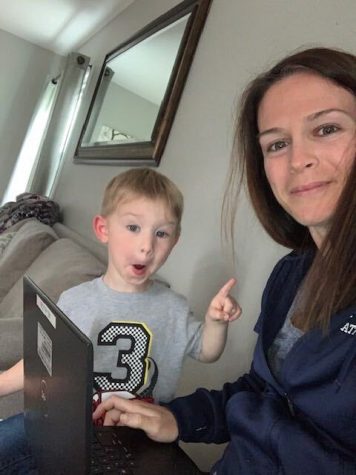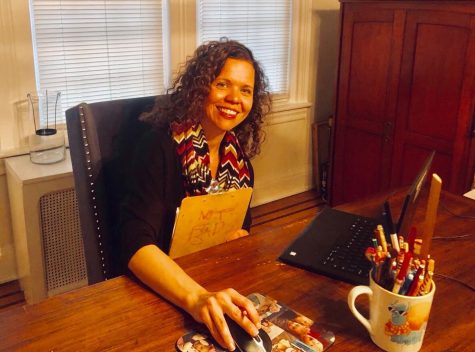The teachers: Methods created on fly; teaching kids while caring for own
'I feel like I am teaching a computer screen'
May 7, 2020

In a Colonial School third grade classroom, 20 or so students listened rapt as Joanne Lombardi explained Chinese culture in early March.
Then the world changed. Coronavirus slammed into New York, and schools closed.
“I feel like I am teaching a computer screen, not a room full of eager faces,” Lombard said. “My job right now is completely different.”
She said it is difficult to apply the skills that she has accumulated over years of teaching when leading an online class. While she would easily have been able to simultaneously teach a lesson and gauge the response of her students in a physical classroom, a virtual setting is a barrier, often resulting in less effective lessons and class participation.
“What I love most about my job,” she said, “is the relationship and rapport I try to build with each student. That relationship fosters the educational process of young children.”
Pelham Middle School art teacher Christina Levi misses her daily interactions with students. “Nothing beats normal school,” she said.
Levi said that she has found it difficult to create interesting and engaging assignments since students may not have access to all the necessary materials at home. Video demonstrations are not quite as effective as those she would be performing in person, so Levi has adapted her curriculum to better utilize digital programs like photo editing sites.
She misses the comfort that a familiar routine provides, and looks forward to returning to the normalcy of school that is “often taken for granted.”
“It’s been hard explaining to my own children, one of whom is only five years old, why we can’t see family or friends,” said Pelham Memorial High School English teacher Courtney Kiessling. Like many parents, Kiessling has tried to caution her children without creating “overwhelming fear.” With all aspects of her life now under one roof, she said, “I feel more busy than before!”
Teachers have faced great change since the coronavirus crisis cancelled school for, as it turned out, the rest of the year. They’ve had to adapt to new ways of teaching invented on the fly and implemented in waves. They are offering lessons to their students while often surrounded by their own children. Many industries and activities paused. Education did not.
Amy Lucas, a physical education teacher in both the middle and high school, said she and her husband are both working full time from home while also trying to keep their three- and five-year-old busy. “Our day consists of snacks, a little schooling, and some shows and apps all while hopping on Google Meet with my classes and colleagues on and off throughout the day,” Lucas said. “It sure is exhausting!”
Lombardi’s family, on the other hand, is elsewhere, presenting its own worries. “I feel concerned about my family every day,” she said. “Thank goodness for FaceTime, though.”
For students who are at home with their families, Lombardi emphasized the importance of taking on responsibilities to make things easier. “By doing your chores, your homework, attempting to get along with siblings,” she said, “you can allow your parents to take care of the more important things going on and everything in the house will be less stressful.”
Especially in households with young children, “parents and caregivers have also had to become teachers in their own homes overnight,” so even small gestures to help around the house are valued more than ever, Lombard said. From her experience, Lombardi said, Pelham schools have done well connecting their students socially and emotionally.
“Seeing your classmates and teacher is a powerful connection to the outside world,” she said.
Ron Martucci, a fourth grade teacher at Colonial, is impressed by how quickly both students and teachers have adapted to the use of Google Classroom and Google Meet. Especially at the elementary level, this increase in independent technology usage has been a huge shift for many.
Martucci and his wife are at home with four kids, with things going well.

“My older boys miss school,” he said, “but they’re keeping each other company, and…my younger daughters seem to enjoy having their siblings around more to play with.” He and his wife are happy to be spending more quality time with their children, but like many others, he said, “We all miss seeing grandparents, cousins and friends.”
Melissa Schluter, a seventh grade math teacher, is grateful for the increased family time that social distancing has given her. She takes nightly walks and plays games with her family; in fact, she said, her free time is the aspect of her life that has changed the most since the closure. As far as her classes, Schluter said she has worked with other teachers to find ways to create meaningful lessons and maintain relationships with her students.
Lucas, the physical education teacher, said since her class doesn’t typically occur in a classroom setting, she has had a very different experience adapting her lessons to an online platform. “When we left school that Thursday,” she said, “I expected to be back Monday morning.”
Lucas has been providing her students with workouts to complete independently. “It’s hard to find motivation to get them done and we understand that,” she said. Without the connection that she would be able to create with her students on a daily basis, Lucas has had a hard time gauging “how they’re feeling by just seeing or hearing them once a week.”
Kiessling, the English teacher, started planning as surrounding districts began taking steps. “I started imagining what activities in both reading and writing would be the easiest to assign and teach from a distance,” she said. Some of her classes were given “independent reading books” to take home in preparation.
The Shakespeare unit, which typically concludes the year, “won’t be the same as being on stage live with our peers,” she said.
Some of Kiessling’s other classes were a bit more difficult to adapt. With the SAT/ACT test prep course, which is centered largely around the testing experience, the curriculum has been challenging to recreate in students’ homes. Although Kiessling said that she has seen college professors adopt a format requiring students to film themselves completing their tests, she finds this method extreme and has yet to enforce such regulations.
Regardless of the class, though, Kiessling recognizes the new difficulty in gauging attention and understanding without actually being able to “look into the faces” of her students. Particularly when it comes to the varying comfort levels of students participating online, she has had trouble keeping classes engaged.
In his transition to distance learning, Joseph DiBello, a high school science teacher, has found that “setting boundaries for work and relaxation has been important.” Teaching from the comfort of his home isn’t quite comfortable; he has worked to consciously separate his routines to keep himself productive and avoid losing track of time.
DiBello is fortunate to have previous experience with various educational applications and software, so although he has faced challenges “finding ways to adapt… science labs and research presentations to a digital format,” he was not entirely unprepared. For issues beyond his own capabilities, he said, “our science department is a close knit team, and we’ve all been helping each other through this (by) sharing ideas and strategies. That’s been the best part of this experience.”
High school social studies teacher David Moskowitz had “been doing quite a bit of podcasting” before the closure, so his students’ experience with the platform made the change much easier. “The difficult part of this,” he said, “is responding to the immediate needs of the students.” With only thirty minutes of class time, Moskowitz finds that there is limited time to address each student’s concerns, and group interaction and collaboration has been “greatly curtailed.”
Although Moskowitz is grateful for technology’s ability to bridge the gap between family and friends, he knows that “it is only a substitute.” This time apart has allowed him to put these relationships into perspective. “My connections to my family are becoming even stronger,” he said. “Sometimes in our hectic lives we neglect that.”
Also a social studies teacher, Dexter Jackson is finding technology to be a valuable resource for his sixth grade classes. “Nothing has prepared me for teaching in this manner,” he said. Aside from the expected loss of routine and social contact, Jackson misses the little things that he took for granted, like picking up a slice of pizza on the way home from work or simply running out to the store.
He is confident, though, that the community in Pelham will remain resilient through the pandemic. “We will mourn for the citizens who suffered losses, and help those whose lives were greatly impacted in other ways by this pandemic, and we will bounce back as we always have, because we are Pelham strong.”
Mrs. Joanne Lombardi • May 8, 2020 at 11:31 am
I am so impressed with this news story. You covered so many bases; so many topics that differnt teachers are feeling. It was very interesing and informative and the “news writing” was professional. Thank you for including me and my opinions and feelings, as well.
Mrs. Joanne Lombardi